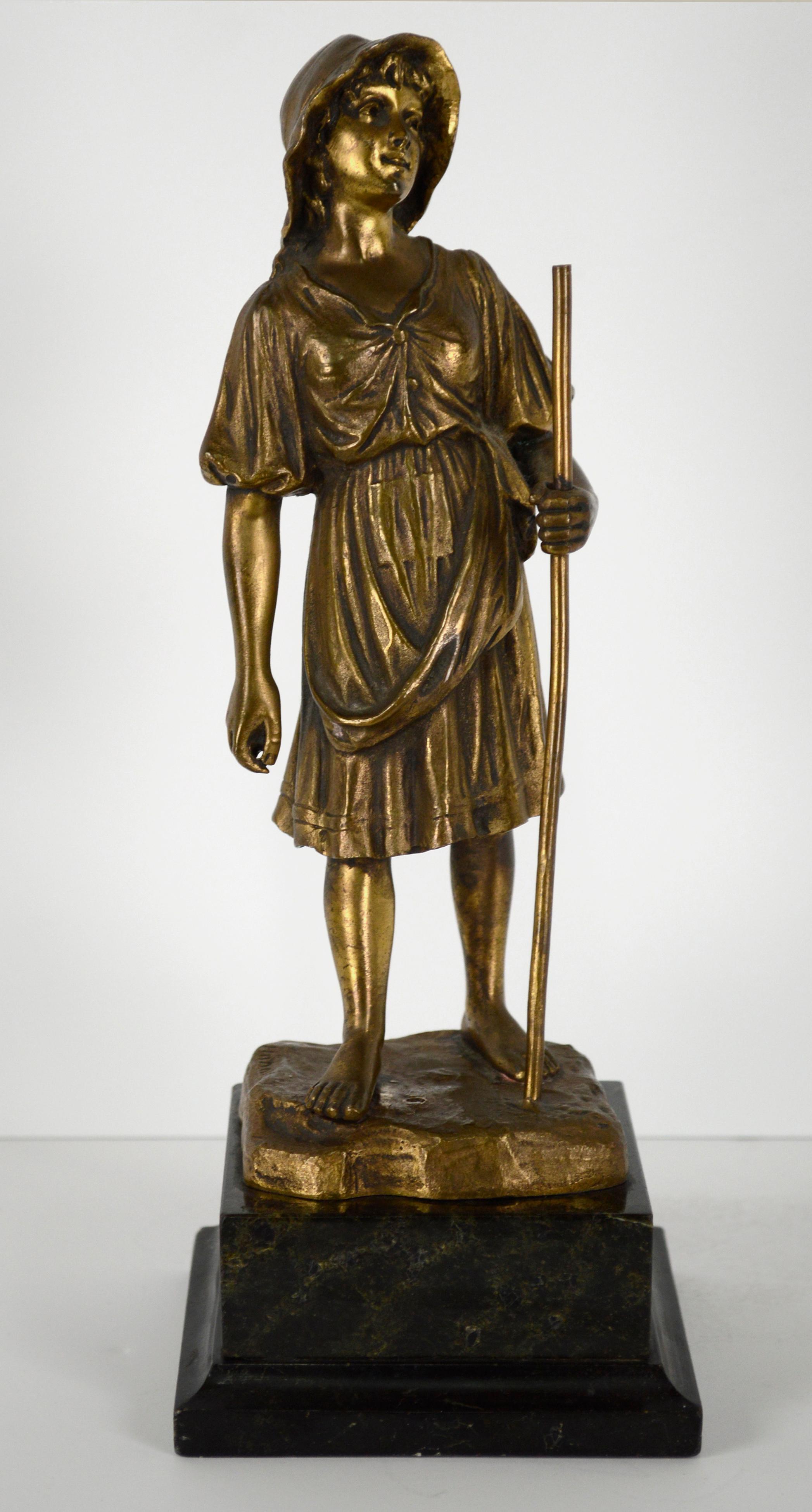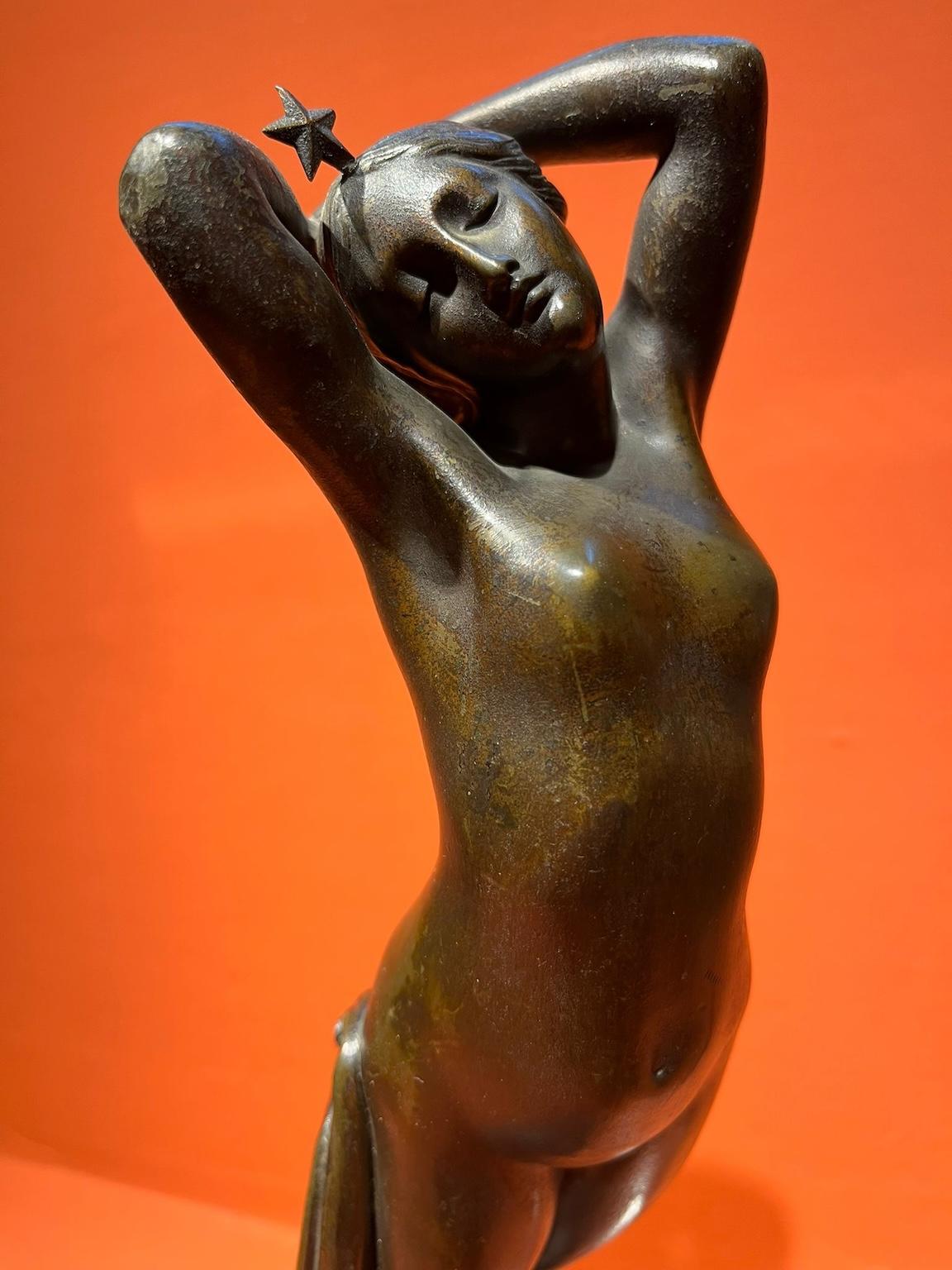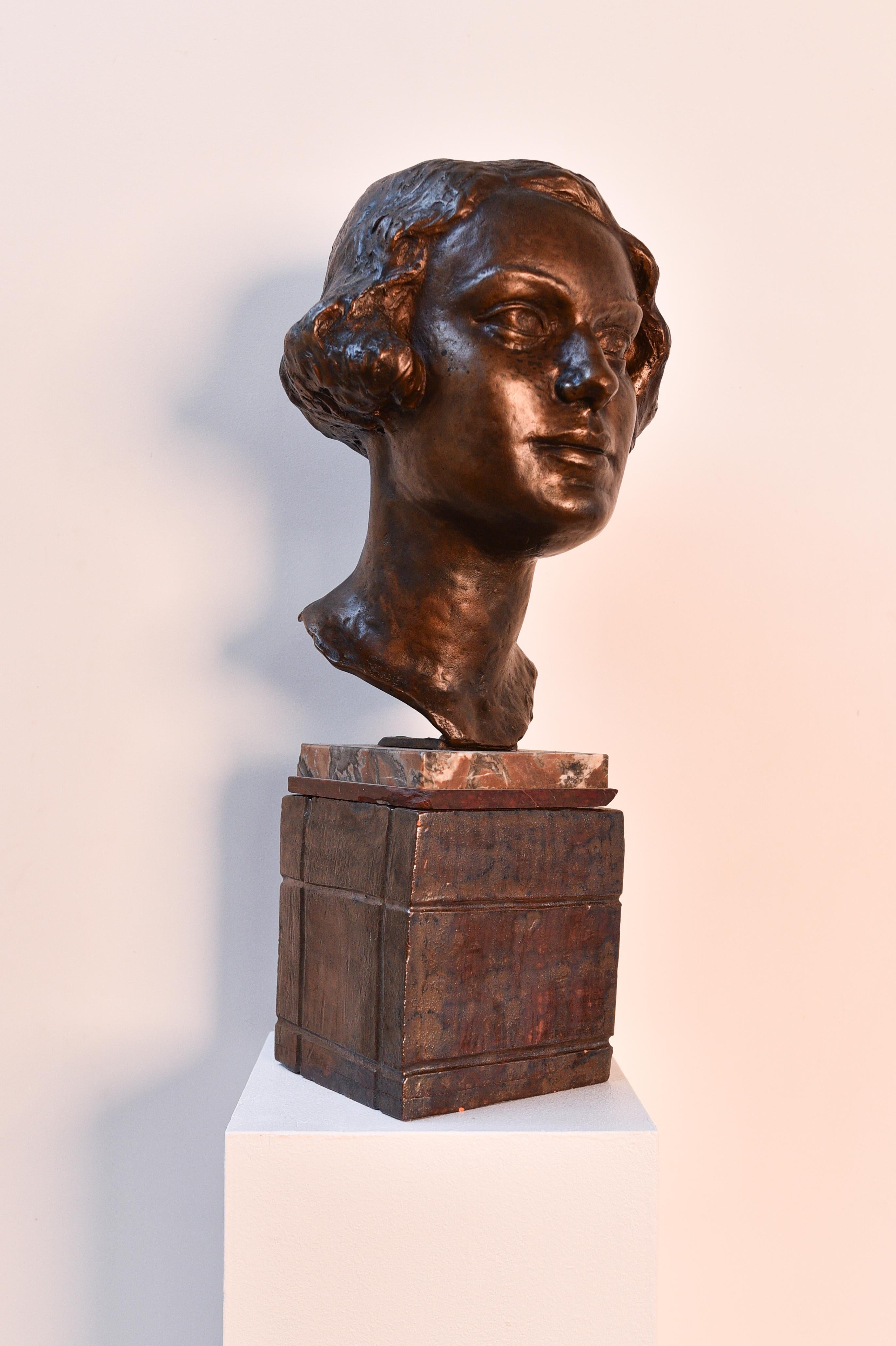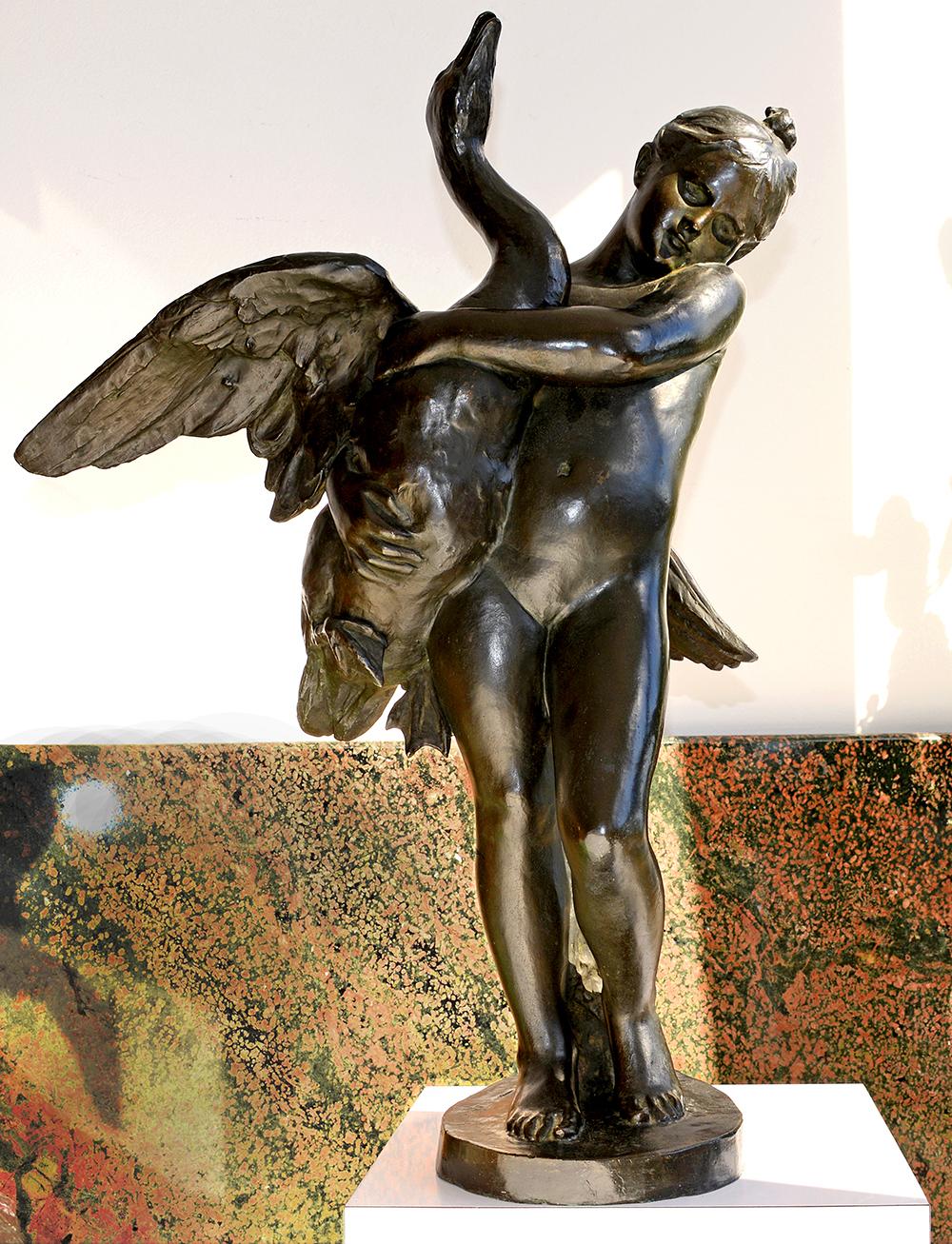Items Similar to La Cothurne
Want more images or videos?
Request additional images or videos from the seller
1 of 9
Agathon LéonardLa Cothurne1901
1901
About the Item
"La Cothurne" 1901
Gilt Bronze
Approx 21.5" High (to raised hand)
Signed and Dated
Foundry Mark "Susse Freres"
Originally modeled in white biscuit porcelain this Greek dancer is a from a set of eight created for a dining table. They were immediately successful when they were exhibited in the Sevres pavilion at the 1900 Exhibition. Individual figures could be ordered and "La Cothurne" proved the most popular. Their success led to the firm of Susse buying the right to cast versions in metal.
Agathon Leonard (1841-1923) is one of the well-known French Art Nouveau sculptors. Born in Lille in 1841, he first studied there before moving to Paris where he studied at the Ecole des Beaux Arts under Eugene Delaplanche.
He gained recognition at the annual Expositiones Universelles, winning a Silver Medal there in 1889 and gold in 1900. His most important piece, Jeu L'echarpe, was the best known series of Sevres production at the turn of the century and sold out at the 1900 Expo in Paris and later was given as a gift by the French Gov't to Nicholas II at the Hermitage.
His bronzes were cast at the Susse Freres Editeurs Foundry. He worked also in marble, quartz and ivory. He also produced Art Nouveau medallions, statuettes and pottery.
His work is held at the Victoria & Albert Museum, the Art Institute of Chicago, and Abbeville and Nantes Museums.
He became a member of the Societe des Artistes Francois in 1887 and the Society Nationale des Beaux-Arts in 1897. He was made a chevalier of the Legion d'Honneur in 1900.
- Creator:Agathon Léonard (1841 - 1923, French)
- Creation Year:1901
- Dimensions:Height: 21.5 in (54.61 cm)Width: 6 in (15.24 cm)
- Medium:
- Movement & Style:
- Period:
- Condition:
- Gallery Location:Missouri, MO
- Reference Number:1stDibs: LU74732666973
About the Seller
5.0
Vetted Seller
These experienced sellers undergo a comprehensive evaluation by our team of in-house experts.
Established in 1970
1stDibs seller since 2017
142 sales on 1stDibs
Typical response time: 22 hours
- ShippingRetrieving quote...Ships From: Missouri, MO
- Return PolicyA return for this item may be initiated within 2 days of delivery.
More From This SellerView All
- Study AimBy Carl KaubaLocated in Missouri, MOCarl Kauba "Study Aim" c. 1920 Bronze with Brown Patina Signed approx. 9.5 x 10 x 4 This Austrian sculptor was born in Vienna in 1865. His teachers were Karl Waschmann (1848-1905), known for his ivory sculptures and portrait plaquettes of contemporary celebrities, and Stefan Schwartz (1851-1924), who exhibited in Paris, including the Exposition Universelle of 1900 where he won a gold medal. Kauba's intricate bronzes, imported to the United States between 1895 and 1912, were cast at the Roman Bronze Works. Kauba was part of the nineteenth-century tradition of polychrome bronze sculpture. There were several types of patinas on a single statue: he could render the color of buckskin, variously tinted shirts, blankets, feathers, as well as beaded moccasins. Reportedly, Kauba came to America around 1886. Inspired by the Western tales of German author Karl May, he traveled to the West and made sketches and models. Critics, however, pointed out inaccuracies of costume and other details. For instance, the guns that his "mid-nineteenth-century" figures use are models produced after 1898. Apparently he did all of his works back in Vienna. Besides the variety of color, Kauba's bronzes show a great range of textures and his style is highly naturalistic. The sculptor loved ornament, some of which he rendered with coiled wire for reins, rope and feathers in headdresses. He successfully rendered figures in motion and often executed compositions with more than one figure. Berman (1974) illustrates non-Western subjects by Kaula, such as the pendants Where? and There (ca. 1910), a seated Scottish couple, impressive in the expressions and the details on patterned fabrics of both sitters. Another genre piece is Buster Brown...Category
Early 20th Century Realist Figurative Sculptures
MaterialsBronze
- Going into BattleBy Carl KaubaLocated in Missouri, MOCarl Kauba "Going into Battle" c. 1920s Bronze with Brown Patina Signed approx 10 x 10 x 4 (including wooden base) This Austrian sculptor was born in Vienna in 1865. His teachers were Karl Waschmann (1848-1905), known for his ivory sculptures and portrait plaquettes of contemporary celebrities, and Stefan Schwartz (1851-1924), who exhibited in Paris, including the Exposition Universelle of 1900 where he won a gold medal. Kauba's intricate bronzes, imported to the United States between 1895 and 1912, were cast at the Roman Bronze Works. Kauba was part of the nineteenth-century tradition of polychrome bronze sculpture. There were several types of patinas on a single statue: he could render the color of buckskin, variously tinted shirts, blankets, feathers, as well as beaded moccasins. Reportedly, Kauba came to America around 1886. Inspired by the Western tales of German author Karl May, he traveled to the West and made sketches and models. Critics, however, pointed out inaccuracies of costume and other details. For instance, the guns that his "mid-nineteenth-century" figures use are models produced after 1898. Apparently he did all of his works back in Vienna. Besides the variety of color, Kauba's bronzes show a great range of textures and his style is highly naturalistic. The sculptor loved ornament, some of which he rendered with coiled wire for reins, rope and feathers in headdresses. He successfully rendered figures in motion and often executed compositions with more than one figure. Berman (1974) illustrates non-Western subjects by Kaula, such as the pendants Where? and There (ca. 1910), a seated Scottish couple, impressive in the expressions and the details on patterned fabrics of both sitters. Another genre piece is Buster Brown...Category
Early 20th Century Realist Figurative Sculptures
MaterialsBronze
- The Hunter and HoundBy Pierre Jules MêneLocated in Missouri, MOPierre-Jules Mene "The Hunter and Hound" (Le Valet de Limier) 1879 Bronze approx. 19 x 8 x 14 inches Signed PIERRE JULES MENE (1810-1879) Pierre...Category
1870s Realist Figurative Sculptures
MaterialsBronze
- Little Red Riding Hood InkwellBy Antoine BofillLocated in Missouri, MOAntoine Bofill "Little Red Riding Hood" Bronze Inkwell 6H x 10W x 6D Signed Inscribed: 25 Septembre 1920 Antoine Bofill was born in Barcelona i...Category
1920s Realist Figurative Sculptures
MaterialsBronze
- Don Quixote Bas Relief in Original Velvet BoxBy Salvador DalíLocated in Missouri, MO"Don Quixote" 1979 Bronze (encased in original velvet box) Signed Lower right Numbered Lower Left 157/215 Size of Relief: 27" x 18.5" Size of Velvet box: 29.5" x 21" x 3.25" Provenance: Martin Lawrence Galleries Salvador Felipe Jacinto Dali was born May 11, 1904 in the small Spanish town of Figueras in the province of Catalunya. The name 'Salvador' had been given to an older brother who died in infancy. When Dali was born the name was passed on to him. No one could have known just how revolutionary and important this name would become to the art world. Growing up, Dali was a difficult child and refused to conform to family or community customs. Dali's father, a respected notary, his mother and younger sister all encouraged Dali's early interest in art. In fact, a room in the family home was the young artist's first studio. Early on, Dali's talent was already refined beyond his years, and with each year his talent only grew, as did his interests. After receiving private art lessons in Figueras for some time, Dali enrolled at the Escuela de Pintura, Escultura y Grabado de Bellas Artes de San Fernando in Madrid in 1921. There he joined an avant-garde circle of students that included film-maker Luis Bunuel and poet-dramatist Federico Garcia Lorca. Although Dali excelled in his academic pursuits, he never took final examinations, deeming that he had no need for the type of education offered by formal schooling. He was expelled and reinstated, yet it mattered little to him. Salvador Dali's passion for the arts and his need to experience life on his own terms could not be met within the confines of school. He left. This did not sit well with Dali's father however, and Salvador was subsequently disowned. With no true home left to him, Dali moved into a fisherman's shack in the small village of Port Lligat, two miles from Cadaques and not far from the French border. Port Lligat would become the site of Dali's future mansion home where he would spend many years of his life. It was at this time that Dali came under the influence of two forces that shaped his philosophy and his art. The first was Sigmund Freud's theory of the unconscious, introduced to Dali in Freud's book The Interpretation of Dreams. The second was his association with the French surrealists, a group of artists and writers led by the French poet Andre Breton. When Dali visited Paris for the first time, he was introduced to the leading surrealists in the movement, but because of his lack of interest in politics, he was eventually shunned by this group. It was also around this time that Dali met the woman who was to become one the most important people in his life... his wife and soul mate, Gala. Gala was a Russian girl...Category
1970s Surrealist Figurative Sculptures
MaterialsBronze
- Preparing to RideLocated in Missouri, MOPreparing to Ride By. George B. Marks (American, 1923-1983) Signed and Dated Throughout his artistic career, George Marks’s work was always guided by the...Category
1970s American Realist Figurative Sculptures
MaterialsBronze
You May Also Like
- Early 20th Century Bronze Figure Sculpture, Shepherd Girl with Staff StatueLocated in Soquel, CAWonderful miniature bronze cast figurative sculpture of a young barefoot shepherd girl holding a staff by R. Hobold (German, 19th c). The girl is dressed in a flowing peasant dress a...Category
Early 20th Century Jugendstil Figurative Sculptures
MaterialsMarble, Bronze
- 19th century French mythological figurative female bronze statuetteBy Joseph PolletLocated in Florence, ITLate 19th-century bronze figure derived from a work by Jean Michel-Angel Pollet-a Palermo artist of French parents who was a pupil of Bertel Thorvaldsen and Peter Tenerani - titled ...Category
Late 19th Century Art Nouveau Nude Sculptures
MaterialsBronze
- Antoine Bofill Art Nouveau Nude Bronze Sculpture, circa 1900By Antoine BofillLocated in Dallas, TXThis is one of Antoine Bofill's best models, being a signature Art Nouveau nature form with a beautiful nude nymph gazing upon a bumble bee insect. The patina on this statue figure i...Category
Early 1900s Art Nouveau Figurative Sculptures
MaterialsBronze
- Early 20th century art nouveau bronze buste of a woman on a ceramic socleLocated in Oostende, BEUnsigned bronze buste of a woman, with fine characteristics. The sculpture was mounted on a hand-made ceramic socle with a marble top. Very heavy, solid and qualitative piece.Category
Early 20th Century Art Nouveau Figurative Sculptures
MaterialsMarble, Bronze
- Nude Girl and Swan BronzeLocated in Miami, FLThis stylized figural study captures a young girl restraining a struggling swan trying to take flight purportedly by Marius Jean Antonin Mercié, bearing the incised signature “Mercié” on the base.. The work is quite heavy weighing in about 65 lbs and boasts an opulent dark patina. Unlike his signature work Gloria Victis, that has numerous versions, reproductions and casts, Girl and Swan may be of just a few casts or may be unique. With Barbedienne foundry mark on the tree stump behind the left foot. Mercie used Barbedienne for many of his works. Purchased from Toulouse Antiques...Category
1910s Art Nouveau Nude Sculptures
MaterialsBronze
- "Art Nouveau Bronze Sculptural of a Boy and Girl", 20th Century by Juan ClaráLocated in Madrid, ESJUAN CLARÁ AYATS Spanish, 1878 - 1958 ART NOUVEAU SCULPTURAL BRONZE OF A BOY AND GIRL signed "Juan Clara" (on the lower left ) sculptural bronze 4-3/8 x 4-3/8 x 3-1/2 inches (11 X 11 X 9 cm.) PROVENANCE Private Spanish Collector Art Nouveau Bronze sculpture representing a boy and a girl sitting on a stool in a funny and surprised attitude to something they are seeing. Sgned "Juan Clará" lower left with the foundry seal and marks on the right side of the bench Juan Clará Ayats. Olot (Gerona), 6.XII.1875 - Paris (France), II.1958. Sculptor Student of José Berga at the Olot School of Fine Arts, developed his training in France, first at the School of Fine Arts in Toulouse, in 1896, and from 1901 in Paris. At this stage he lived with his younger brother, José Clará...Category
1920s Art Nouveau Figurative Sculptures
MaterialsBronze
Recently Viewed
View AllMore Ways To Browse
1900 Exhibition
Ivory Art D
Medallion Sculpture
Art Nouveau Dancers
Art Nouveau Marble Sculptures
Art Nouveau Ivory
Antique Ivory Sculpture
Antique Ivory Sculptures
Statuettes Gold
Art Nouveau Medallions
Sculpture Biscuit
Bronze And Ivory Sculpture
Biscuit Porcelain Sculptures
Art Nouveau French Pottery
Marble Sevres
French Provence Pottery
Sculpture Porcelain Dancer
White And Gold Sevres Porcelain




